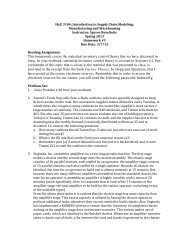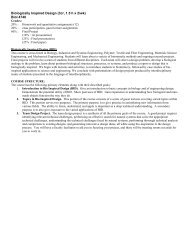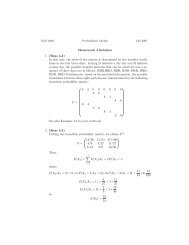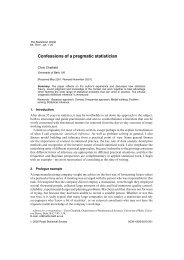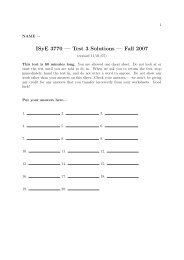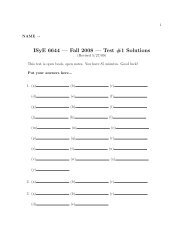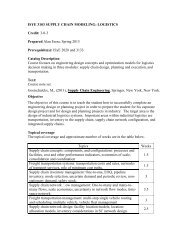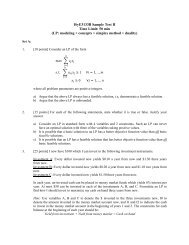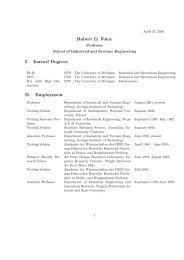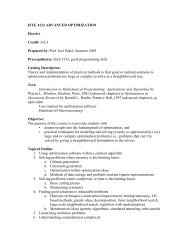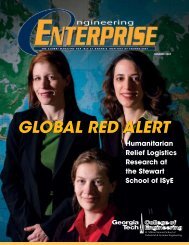Fall 2009 - H. Milton Stewart School of Industrial & Systems ...
Fall 2009 - H. Milton Stewart School of Industrial & Systems ...
Fall 2009 - H. Milton Stewart School of Industrial & Systems ...
You also want an ePaper? Increase the reach of your titles
YUMPU automatically turns print PDFs into web optimized ePapers that Google loves.
I S y E<br />
STEWART SCHOOL OF<br />
BULLETIN<br />
ALUMNI NEWS<br />
Of course, I was a bit apprehensive at first, as I think most<br />
folks are the first time out <strong>of</strong> the hatch. It took maybe an<br />
hour for me to really figure out how to get around efficiently<br />
and not bang into everything like a bull in a china shop. It<br />
was mentally challenging and physically challenging. Your<br />
hands get really exhausted after about seven hours <strong>of</strong> work,<br />
especially dealing with the pressure <strong>of</strong> the spacesuit every<br />
time you open and close your hands. When you come back<br />
in, you are pretty exhausted. For me, my hands were the<br />
most fatigued <strong>of</strong> anything.<br />
How do you train to become an astronaut and do this<br />
kind <strong>of</strong> work?<br />
NASA has a very nice trainer that we use for spacewalks.<br />
We use a giant pool that is about 40 feet deep, 200 feet long,<br />
and 100 feet wide. We climb into our 300-pound spacesuits,<br />
get in the water, and train and train and train and train. I<br />
got the same hand fatigue in the pool that I felt in space. So<br />
it wasn’t something that was new or unexpected. I probably<br />
had about fifteen or so <strong>of</strong> these training events in the pool<br />
to prepare me for the two spacewalks that I executed. The<br />
mental aspect is a little different. I think we are all focused<br />
individuals, but it was still quite a challenge to stay focused<br />
continuously for seven hours.<br />
What was it like being up there with other Tech grads?<br />
It was great. Our crew was interesting. There were seven <strong>of</strong><br />
us: three were Georgia Tech grads and four were MIT grads.<br />
It is pretty unusual to have that kind <strong>of</strong> crew mix. We took<br />
a few pictures with each one <strong>of</strong> our groups, but that was<br />
about the only competitiveness. We loved being up there<br />
representing Georgia Tech and hearing that they mentioned<br />
us at the [Georgia Tech vs. Miami] football game. That was<br />
pretty neat.<br />
Was it hard physically to re-acclimate to Earth’s<br />
atmosphere after you returned?<br />
I think most <strong>of</strong> us will attest that gravity is not your friend<br />
after you’ve been up in space for a few weeks. In space<br />
you are floating around and everything inside your body is<br />
floating around too. Back on Earth, everything has to figure<br />
out where it’s supposed to be again. For instance, my inner<br />
ear was affected—it thought I was still going 17,500 miles<br />
per hour. I had the sensation <strong>of</strong> spinning for 9 to 10 hours<br />
after landing. I could sit there and talk to you, but I’d need to<br />
be holding on to something for stability. My legs were a little<br />
bit weak and wobbly for a few hours because I didn’t use<br />
them for two and a half weeks.<br />
How did you feel after completing your mission?<br />
The first week after we got back, I thought it was a dream<br />
still. I couldn’t believe that it had actually happened and I<br />
did what I did. Our mission was called the “Extreme Home<br />
Makeover: Space Station Edition” since we were redoing the<br />
inside as well as working on the outside <strong>of</strong> the space station.<br />
It’s great to see some <strong>of</strong> our work extending the life <strong>of</strong> the<br />
space station.<br />
What is next for you?<br />
I’m back in the astronaut <strong>of</strong>fice working my technical job.<br />
I am currently supporting my colleagues launching on the<br />
space shuttle. I am also working on the spacewalking suits<br />
and as a Capsule Communicator (CAPCOM) in Mission<br />
Control. Hopefully one <strong>of</strong> these days I will do well enough<br />
that the boss will call me in and ask me if I want to go fly in<br />
space again.<br />
Army Lt. Col. Shane Kimbrough (MS OR 1998) returned to campus on June 26 to speak about his first flight into obit aboard the Space Shuttle<br />
Endeavour. The mission was popularly dubbed the “Extreme Makeover: Space Station Edition.” A crowd <strong>of</strong> more than 200 Georgia Tech faculty,<br />
students, and guests filled the Student Center theater for Kimbrough’s presentation. He introduced the audience to the International Space Station’s<br />
facilities and crew, which included fellow Georgia Tech graduates Eric Boe (MS EE 1997) and Sandra Magnus (PhD MSE 1996). At the end <strong>of</strong> his<br />
presentation, he opened up the floor for a question-and-answer session in which he fielded inquiries about the launch sequence, his spacewalks, his<br />
typical workday in space, and his acclimation to low-gravity. Afterward, Kimbrough signed autographs for the audience in attendance, many <strong>of</strong><br />
whom were local children attending on-campus engineering summer camps.<br />
The Alumni Magazine for the <strong>Stewart</strong> <strong>School</strong> <strong>of</strong> ISyE <strong>Fall</strong> <strong>2009</strong> • 31



